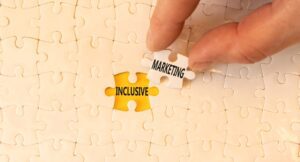
25 Eye-Opening Inclusive Marketing Stats

Social values are shaping consumer decisions and purchase behaviour more than ever, with more people looking for variety. As a result, it’s imperative that brands start to consider inclusive marketing and understand how this can help build genuine connections with their target audience.
Inclusive marketing isn’t as simple as adding diverse images and language to your ads, it’s about embodying diversity throughout your company and aligning your brand values with diversity and inclusion. In this blog, we’re going to run through 30 eye-opening statistics that may make you reconsider your entire marketing strategy.

At Embryo, one of our core company values is ‘togetherness’ and welcoming inclusion and diversity. Collaboration is what drives our creativity and something that we take pride in. If you’d like to learn more about how we can broaden your perspectives and inform your marketing strategy around diversity, get in touch today at 0161 327 2635 or email us at info@embryo.com.
General Diversity Stats:
- 57% of consumers are more loyal to brands that commit to addressing social inequities in their actions (Deloitte).
- 70% of Gen Z consumers are more trusting of brands that represent diversity in ads. (Microsoft Advertising).
- Consumers aged 18-25 years old take greater notice of inclusive advertising when making purchase decisions than consumers 46+ (Deloitte).
- Multicultural consumers make up almost 40% of the U.S. population, but multicultural media spending is only 5.2% of total ad and marketing spend (PQ Media).
- Women, overall, make up more than half of the U.S. population and control or influence 85% of consumer spending (My Code Media).
- 64% of consumers will buy or boycott a brand based on its position on a social or political issue (LinkedIn).
Accessibility Stats:

- 69% of marketers believe that providing accessibility features is important to executing successful marketing campaigns (Capterra).
- 15% of marketers worldwide recalled people with disabilities being portrayed positively in their recent campaigns, putting it at the bottom of the list (Insider Intelligence).
- Almost half (49%) of marketers say that social media is the most difficult platform for accessibility (Capterra).
- 90% of websites are inaccessible to people with disabilities who rely on assistive technology (AbilityNet).
- 82% say they would often return and spend more with a company that provides an accessible online experience (Click-Away Pound).
- 45% of marketers say that education or accessibility training would motivate their company to be more proactive in improving its accessibility (Capterra).
Ethnic Diversity Stats:
- One in three Black consumers doubts the intentions of social media-run businesses that launch Black History Month campaigns and promotions (Insider Intelligence).
- 69% of Black consumers are more likely to purchase from a brand whose advertising positively reflects their race/ethnicity (Think With Google).
- Despite making up 18.7% of the total US population, Hispanic consumers make up a disproportionately small percentage (only 6%) of overall advertising spend (Insider Intelligence, 2021).
- Black consumers’ buying power is expected to reach $1.8 trillion by 2024 and Hispanic buying power is $1.7 trillion today (representing an 11% increase just in the last decade) and by 2024 (LinkedIn).
- 66% of Black consumers are more likely to return to a brand with advertising that authentically reflects their race/ethnicity (Think With Google).
LGBTQ Community Stats:
- 76% of LGBTQ community members think more positively about companies that sponsor LGBTQ community organisations and events (CMI).
- 77% of non-LGBTQ people feel more positively towards brands that include LGBTQ people in their advertisements (GLAAD).
- 71% of LGBTQ+ consumers are more likely to interact with an online ad that authentically represents their sexual orientation (Think With Google).
- On average, non-LGBTQ people who were exposed to LGBTQ people in the media were 38% more likely to become more accepting and supportive of LGBTQ people (GLAAD).
- 67% of LGBTQ consumers are more likely to feel positively toward brands with advertising that demonstrates that men and women have the same capabilities and roles (Think With Google).
- 53% of LGBTQ community members think that corporate presence at LGBTQ Pride events is positive for the community (CMI).
Gender Stats:
- Women, overall, make up more than half of the U.S. population and control or influence 85% of consumer spending (My Code Media).
- Women are 18% less likely than men to apply to a marketing job after viewing it, and when they do, they’re 8% less likely to apply for jobs of higher seniority (LinkedIn).
These Stats Should Underline The Importance of Diversity in Marketing

Many brands have received backlash for their lack of diversity and inclusivity when it comes to marketing, especially in recent years. Therefore, I think it’s fair to say that if not done so already, brands need to understand the importance of diversity and how it can positively impact your reputation and loyalty from customers.
Creating campaigns that voice diversity and inclusivity allow brands to connect with their customers on a deeper level and even expand their reach. With more and more brands entering the digital marketing world, it’s even more important to connect with existing customers and welcome new connections.
If you’d like more information on how we can assist with implementing an inclusive marketing strategy, feel free to get in touch with us today via our contact page, by phone at 0161 327 2635 or by email at info@embryo.com.


